78. Sturmdivision (GEAB07) Army Box The illustrious 78. Sturmdivision has seen combat from the gates of Moscow to Kursk, and now guards the critical point at Orsha. The high concentration of integrated infantry weapons and assault guns makes the unit a very powerful formation. The 78. Sturmdivision will keep the Soviets in check, should they decide to assault! |
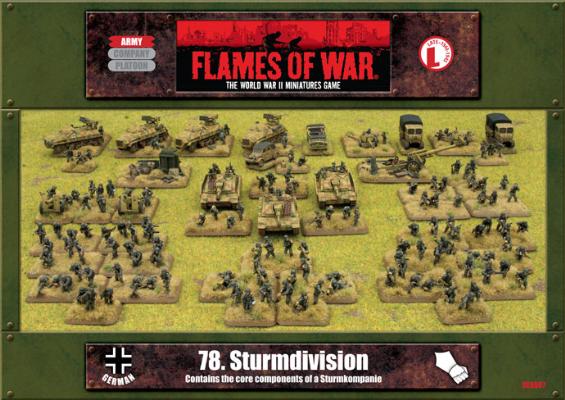 |
The division was originally raised in 1939 as the 78. Grenadierdivision in Stuttgart, Germany. The division participated in the invasion of Russia and advanced to the gates of Moscow, before being forced back. In January 1943, the 78. Grenadierdivision reformed as the 78. Sturmdivision. The motive behind these changes was to create a division with many weapons and few men. Each Sturmkompanie was authorised enlarged infantry platoons and significant increases in heavy weapons. Additionally, each battalion had nine integral 7.5cm PaK40 anti-tank guns, a number usually held by an entire Grenadier regiment. Sturmgeschütz-Abteilung 189 was also attached to the division, along with Panzerjäger-Abteilung 178.Soon after its reorganisation, the 78. Sturmdivision was committed to Operation Zitadelle (Citadel) where the unit fought with distinction at Kursk. |
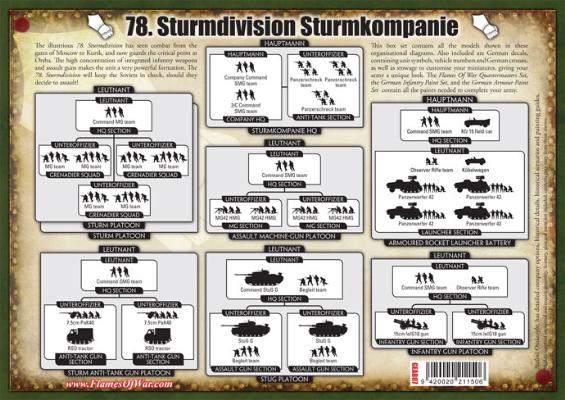 |
By October 1943, the veteran 78. Sturmdivision was placed along the Panther Line near Orsha. It was now part of the XXVII Army Corps along with the 25. Panzergrenadier Division and the 260. Grenadierdivision, and defended the critical junction along the Moscow–Minsk highway. Three years after the German invasion of the Soviet Union, on the 22 June 1944, the Soviets launched Operation Bagration with a huge preparatory bombardment. The initial attacks failed with heavy losses, despite the use of special armoured assault groups by the 11th Guards Army.By the evening of 23 June, the 78. Sturmdivision had withdrawn back in good order, about 5km to its second defensive line. Problems arose when a Soviet reconnaissance patrol discovered a disused narrow-gauge rail line through the swampy forest between the Sturmdivision and the 256. Grenadierdivision. The 2nd Guards Tank Corps pushed through along the rail line, and the Sturmdivision was outflanked. |
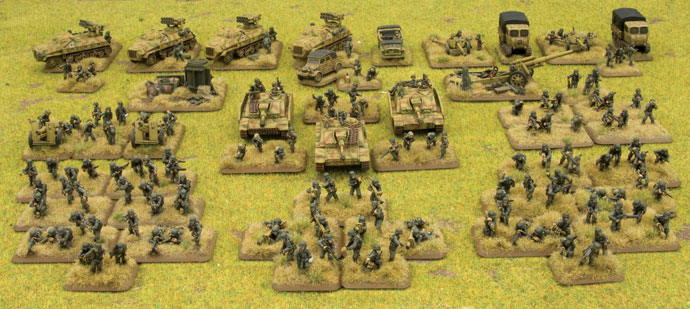 |
On 26 June, the division withdrew again into Orsha, and fell under attack by two Soviet divisions. Meanwhile, the 5. Panzer Division and the Tiger tanks of 505. Schwere Panzer Abteilung arrived to try to stem the Soviet advance. However, by the morning of the 27 June, Orsha had fallen, and the road to Minsk was wide open. The Sturmdivision continued to retreat, abandoning its heavy equipment at the Berezina River. Any stragglers risked attack by units of partisans lurking in the forests. By 5 July, the Sturmdivision had fought from encirclement to encirclement, having conducted a 200km-long fighting withdrawal. The division managed to get clear of the encircling enemy, despite losing the majority of the 78. Sturmdivision and its commander, General Traut. They were not alone, as Army Group Centre lost 17 other divisions completely, with many more severely depleted.Those few survivors that managed to escape the collapse of Army Group Centre were absorbed by the 565th Volksgrenadier Division, and the Sturmdivision would be reformed as the 78. Volksgrenadierdivision a few weeks later. The reformed division would fight through Poland, Silesia and Czechoslovakia. |
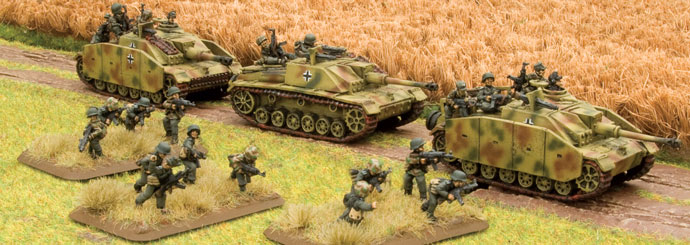 |
Sturmkompanie The Sturmkompanie was organised in early 1943 as a specialised assault division. Its first practical use was at the massive battle of Kursk, where it performed well. The concept of the company went beyond the normal grenadier organisation by giving it a lot more heavy equipment, such as its own integral 7.5cm PaK40 anti-tank guns and a heavy platoon. The company also boasts its own StuG Batterie which lends immediate armoured support whenever needed. |
 |
| 78. SturmDivision Special Rules Pakfront! German defensive doctrine used the Pakfront to efficiently devastate Soviet tank assaults. Guns are deployed carefully with overlapping fields of fire, inflicting maximum damage. The 78. Sturmdivision made expert use of the Pakfront defending Festerplatz Orsha. You may choose your Sturm Anti-tank gun platoon or one of your Anti-tank gun platoons to form a Pakfront. Do not deploy the platoon when you would normally. Instead, it is deployed at the same time as Independent Teams. Field Fortifications Orsha is a critical location and as a result boasts an impressive defence network of earthen and concrete emplacements and trenches. In any game that does not use the Fortifications special rules (page 217 of the rule book), a Sturmkompanie may purchase fortifications from page 64 as a part of their force using their normal points total. All fortifications must be deployed in your deployment area immediately before you or your opponent places an objective. A Sturmkompanie containing more than 50 points of fortifications always defends against another Infantry Company in missions that use the Defensive Battle special rule. |
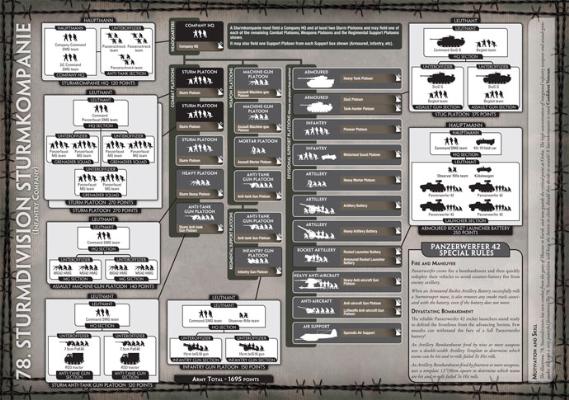 |
The 78. Sturmdivision Army box set contains all the models shown in the expanded organisational diagrams above. Also included are German decals, containing unit symbols, vehicle numbers and German crosses, as well as stowage to customise your miniatures, giving your army a unique look. You wall also find the quick reference sheet above for your army complete with organisation diagrams, special rules and Arsenal. The Flames Of War Quartermasters Set, the German Infantry Paint Set, and the German Armour Paint Set contain all the paints needed to complete your army.For full rules and more on the 78. Sturmdivision see Stalin's Onslaught... More on the Sturmkompanie... Infantry designed by Seth NashVehicles and guns designed by Even Allen Painted by Jeremy Painter and James Brown |
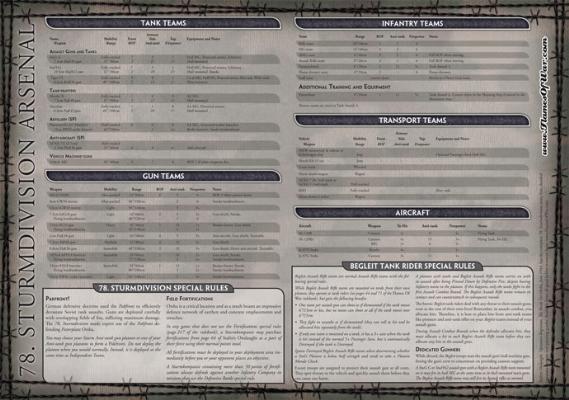 |
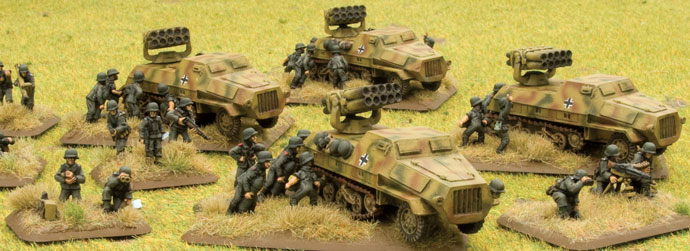 |

Ingen kommentarer:
Legg inn en kommentar